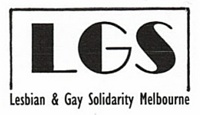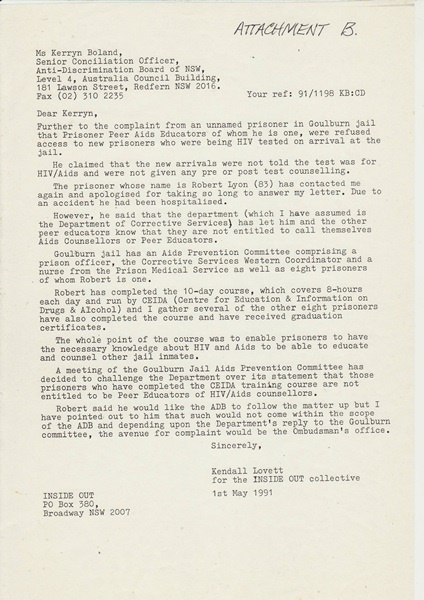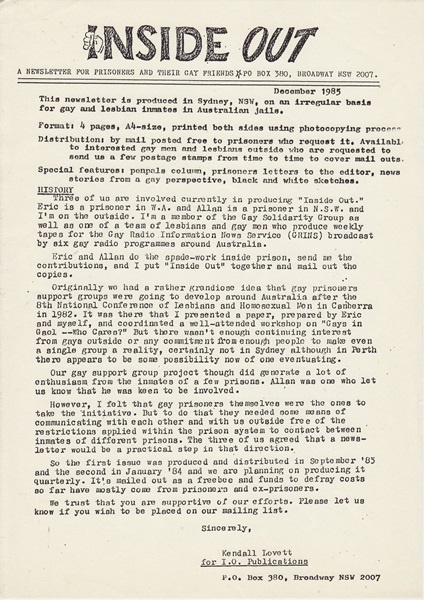



The Inside Out Collective was formed in 1982 with the intention of facilitating support and improving communication between lesbians and gays on the outside and lesbian and gay prisoners in jails throughout the country. It was the initiative of a couple of prisoners, one in Western Australia, the other in a prison in NSW and myself on the outside.
As an active member of Sydney's Lesbian and Gay Solidarity (LAGS) since 1978, I was the correspondence contact for the group with those prisoners who from time to time had sought our assistance. The need for a specific subcommittee became obvious and from the enthusiasm of one of the prisoners the subcommittee became a collective and eventually a separate entity.
As a collective, we decided to present a paper, "Gays in Jail: Who Cares?" and host a workshop at the 1982 National Lesbian and Gay Conference in Canberra. The paper received quite a bit of media attention and considerable interest was generated within the conference but we found that the interest wasn't sustained after the conference participants returned to their home States.
In 1983, we decided to produce a newsletter for gay prisoners and their friends outside. Even though it was called the Inside Out Newsletter we used an alternative name for our stationery, I.O.C. Publishers, so that it could be mailed to prisoners in some States who would only permit inmates to receive publications which came on subscription or gratis from a publishing house. The first newsletter was mailed to some 40 prisoners. The newsletter was also distributed at the 9th National Lesbian and Gay conference held in Melbourne in 1983. From the distribution, we were able to implement our mailing list with interested lesbians and gays on the outside.
In 1984 we presented another paper, "The Prison Business," and hosted a workshop at the 10th National Lesbian and Gay Conference held in Brisbane.
In 1985, the editorial board of the International Gay Association (now the International Lesbian and Gay Assoc.) invited me to submit an article for the Pink Book 1986. Because of my involvement with Inside Out, I was asked to write about the situation of lesbian and gay prisoners in Australia and the state of the law, etc. However, publication of the book was postponed.
In 1987, the International Association requested an update to my previous manuscript which I supplied and the Pink Book was published in 1988.
The newsletter had folded by 1987 mainly because the prisoners who had been so enthusiastic in providing a lot of inside material had all been released and my commitments in other areas had increased and without help I was unable to produce the newsletter. Nevertheless, I continued correspondence and contact with a number of long-term prisoners and following up their requests for advice and legal referral which has always been part of Inside Out's support work. In 1988, we extended that kind of support and awareness into the gay and lesbian communities by means of a regular weekly segment in the gay and lesbian (Wild G.A.L.S.) programme on Radio Skid Row FM, Saturday nights. After 3 years it is stll an important part of that programme. In 1991, Inside Out made a submission to and gave oral evidence at the Public Inquiry by the NSW Anti-Discrimination Board into Discrimination against People who have or are presumed to have HIV/AIDS.

TO THE ANTI-DICRIMINATION BOARD OF NEW SOUTH WALES PUBLIC INQUIRY into discrimination against people who have or are presumed to have HIV/AIDS, in Employment, Provision of Goods and Services (including Medical and Health Services) and accommodation.
This SUBMISSION is made by INSIDE OUT, Post Office Box 380, Broadway NSW 2007, a support collective for lesbian and gay prisoners, formed originally in 1983 by members and friends of the Gay Soldiarity Group Sydney.
Submission author: Kendall Lovett, I.O.Collective member, 31 JULY, 1991.
Because this submission is concerned solely with the NSW prisons system, the administration, the staff and the inmates of the jails, INSIDE OUT urges the Board to accept that such government institutions must be considered as falling into all three categories for the purpose of the Inquiry, especially as the NSW Government is in the process of privatising some of its jails/prisons.
INSIDE OUT hopes to show by this submission that current laws, policies and particularly practices in NSW prisons and the Department intensify the degree of discrimination evident in the jails.
There will be also some few recommendations from INSIDE OUT.
1. WHEN RIGHTS ARE LOSTConfined to a jail, a person loses all citizen rights. Prisoners have no rights only certain privileges which can be withdrawn for any reason at any time during incarceration. Even if the government of the day says that it recognises that some rights exist for prisoners, that does not mean that those rights automatically apply in all jails.
In reply to a letter from INSIDE OUT regarding the "return to sender" of previously acceptable community newspapers sent to individual prisoners in Goulburn Jail, Michael Yabsley, at the time the NSW Minister for Corrective Services, wrote on 19 November 1990 as follows:-
"Superintendent Klok of Goulburn Gaol allows inmates to purchase papers, magazines and books daily, provided the inmate complies (with number of publications permitted on a daily basis). Superintendent Klok does not permit papers and magazines coming into the institution through the post or visits. This is in accordance with the new prisoners' private property policy introduced on the 9th September 1990. Not all superintendents would necessarily follow Superintendent Klok's lead and indeed it is a matter for each superintendent to decide."
INSIDE OUT views this example as indicative of the constant discrimination practised by authorities against prisoners. Regulations are framed so that they may be interpreted in a fashion that very often allows jail superintendents to indulge their prejudices.
Where HIV/AIDS is concerned, prejudice, homophobia and ignorance displayed by prison superintendents and staff as well as by Department of Corrective Services administrators can be said to have produced AIDS education discrimination in NSW prisons. As far as INSIDE OUT is aware there have been no adequate HIV/AIDS educational programmes provided by the Department for its superintendents and prison officers. But prisoners did it for themselves where they could despite the opposition.
It is now some years since a small group of prisoners in Bathurst jail initiated a self-help education scheme which eventually became the model for the Prisons Peer Education Programme. The project is coordinated by the Centre for Education and Information on Drugs and Alcohol (CEIDA) and has been to some extent successful in overcoming the prejudice and the rigidity of some people within Corrective Services senior administration.
CEIDA staff run courses for prisoners who have volunteered to train in various aspects of HIV transmission and prevention and issues surrounding HIV testing and the support of HIV-positive inmates. They graduate as Peer Educators. (See Attachment A.)
Earlier this year, the prisoner whose certification is tendered as Attachment A contacted INSIDE OUT complaining that the Peer Educators were being denied access to incoming prisoners at Goulburn jail. These new prisoners, he claimed, were HIV tested without being told why or for what they were being tested. The Prisoner Peer Educator asked for advice on complaint procedure to the ADB.
An Inside Out Collective member explained the situation to the ADB Senior Conciliation Officer who advised that because the complaint involved a prison and the Goulburn Committee had complained to the Department, the more appropriate avenue would be the NSW Ombudsman's Office. (See Attachment B.)
Prejudicial attitudes and obstruction by jail staff, officers and administrators re HIV/AIDS have been brought to the attention of INSIDE OUT directly by prisoners. Checking on the validity of the claims of prisoners by INSIDE OUT is seldom a viable proposition because the jail administration is not open to outsiders.
A young prisoner who at the time was confined at Long Bay complex when he was HIV tested on Friday, 14 December 1990. He received no pre or post counselling whatsoever. He was still waiting for the results of his test when he was moved to the new jail at Lithgow in February. On the 4th March, 1991, he was informed that the result and details of his HIV test could not be found at Long Bay and had to be presumed lost.
At Maitland jail, INSIDE OUT learned that there were two prisoners who were members of the Prison AIDS Committee and who were HIV positive, wanted to correspond with HIV positive people outside. INSIDE OUT contacted the People Living with Aids support group and asked the group to publish the request of the two prisoners in its newsletter TALKABOUT, which it did. INSIDE OUT also suggested to the two HIV-positive prisoners that they advise the AIDS Committee at Maitland to apply to receive National AIDS Bulletin and Sydney Star Observer so that the committee could keep abreast of the information on treatment and support. INSIDE OUT had learned from the Goulburn prisoner peer educator (refer Attachment A) that the only publications permitted to come in from outside were those that dealt with HIV/AIDS and then only if they had received approval from the jail authorities.
From a health point of view this is discrimination and discriminates against HIV-positive people in prison particularly. A prison superintendent's prejudice could conceivably prevent a specific HIV/AIDS educational publication from being received in that jail. It took approximately three months before the prestigious National AIDS Bulletin was approved for the Goulburn AIDS Prevention Committee.
Recently in Lithgow jail a prisoner died from AIDS. Another prisoner informed INSIDE OUT that after his death prison officers acted as though the cell was a "quarantine area." The dead prisoner's property was collected in large, plastic hospital-type bags labelled, according to the other prisoner, "Warning! Contaminated Waste." After almost a decade, obviously these prison officers have not been made aware of the fact that HIV/AIDS is not transmitted by casual contact.
Towards the end of July this year, INSIDE OUT learned from a long-time prisoner in Parramatta Jail that he had been diagnosed HIV-positive. In a letter to INSIDE OUT he wrote" "I have a new date for my release but who knows or cares anymore what happens. The past two years have been the worst I've had in my life but I'm not going to complain to you about them." He then went on to say that he had to beg a prepaid postage envelope from another prisoner so that he could write to INSIDE OUT. He currently does not receive any prison subsistence money (which is a pittance) because he takes his entitlement in tobacco. He said he has taken up smoking again to ease the boredom. "I don't even have enough for basic needs," his letter continued, "but not to worry, it doesn't matter anymore."
It is unlikely that this prisoner would receive much support or information about alternative treatments or how to care for himself because he is openly gay and in protection. INSIDE OUT is not aware either if there is an AIDS Committee operating in Parramatta Jail. The most INSIDE OUT can do initially is to photocopy what it considers to be relevant, practical and educational literature and use the plain side of the photocopy as notepaper on which to write letters of support to him, and visits if he requests them.
INSIDE OUT believes that these examples of the kind of discrimination that is practised in NSW jails are merely the tip of the iceberg.
In a workshop at the National AIDS Conference held in Hobart in 1988 Bernie Matthews of the Prisoners Action Group told the audience that two years earlier in a Long Bay prisoners magazine the following advice was included for the prison population. "Don't share your needle! Buy your own fits (Syringe). Soak it in Blue Gum (a disinfectantused in NSW prisons at that time) or in bleach before you use it. Rinse your syringe 5 times before you have a hit.
That advice,Matthews said, was from a group of prisoners who felt concerned within the system not only for their peers but for their families when prisoners were released. What happened to that advice? Matthews said it got raised in the NSW Parliament by the then shadow minister in the Liberal Party opposition, Michael Yabsley. In his media release, Yabsley said: "Whatever the merits of education about AIDS, this kind of material produced with taxpayers' money amounts to the promotion of heroin and other illegal drugs in the prison system."
The prison magazine did not last long after that.
The controversial urine tests for traces of drugs being used by prisoners has been estimated to cost about 1/2 million dollars annually, according to Matthews, based on a cost factor provided by the Macquarie University Pathology Department in 1988, which Yabsley instituted after he became Corrective Services Minister. These tests, Matthews claimed, are simply to find out how many IV drug users there are in NSW prisons. Yet the issue of condoms remains unresolved and disposable needles unlikely to be made available in NSW prisons regardless of how many IV drug users urine analysis discovers.
RECOMMENDATIONS1. That unrestricted access to publications dealing with HIV/AIDS education, information, new developments in treatments and alternative treatments be permitted to all prisoners in NSW jails and that no approval for their receipt be required;
2. That all prison superintendents, prison officers and staff in the employ of the Department of Corrective Services receive specific HIV/AIDS education including manner of transmission and latest treatments;
3. That to overcome the objections of the prison officers to the dispensing and collection of condoms, that a machine be installed that dispenses condoms and located possibly where buy-ups occur and that the manufacturer of dispensing machines be approached to provide a machine that also destroys condoms;
4. That the HIV Peer Education Programme receive increased funding so as to further educators from AIDS organisations who can be engaged to step up the education process for prisoners.
INSIDE OUT does not believe that confidentiality can be achieved in the prisons regarding the HIV status of a testing positive prisoner. However, INSIDE OUT is of the opinion that regular positive health education on HIV will reduce the stigma and fear associated with HIV/AIDS among superintendents, staff, prison officers and prisoners. If that can be achieved then discrimination will cease to be a problem in the jails.
----------------------------





Mannie De Saxe also has a personal web site, which may be found by clicking on the link: RED JOS HUMAN RIGHTS ACTIVISM
Mannie's blogs may be accessed by clicking on to the following links:
MannieBlog (from 1 August 2003 to 31 December 2005)
Activist Kicks Backs - Blognow archive re-housed - 2005-2009
RED JOS BLOGSPOT (from January 2009 onwards)
RED JOS BLOGSPOT ALPHABETICAL INDEX
